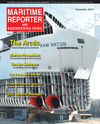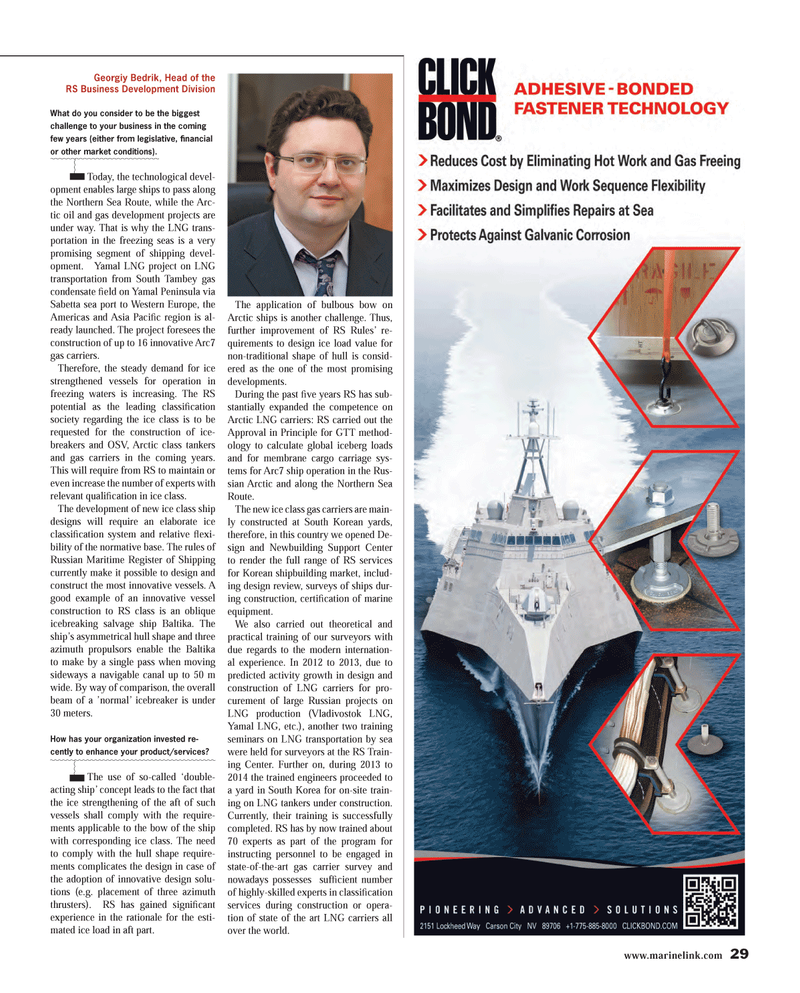
Page 29: of Maritime Reporter Magazine (September 2014)
Marine Propulsion Edition
Read this page in Pdf, Flash or Html5 edition of September 2014 Maritime Reporter Magazine
www.marinelink.com 29
What do you consider to be the biggest challenge to your business in the coming few years (either from legislative, fi nancial or other market conditions). Today, the technological devel- opment enables large ships to pass along the Northern Sea Route, while the Arc- tic oil and gas development projects are under way. That is why the LNG trans- portation in the freezing seas is a very promising segment of shipping devel- opment. Yamal LNG project on LNG transportation from South Tambey gas condensate fi eld on Yamal Peninsula via
Sabetta sea port to Western Europe, the
Americas and Asia Pacifi c region is al- ready launched. The project foresees the construction of up to 16 innovative Arc7 gas carriers.
Therefore, the steady demand for ice strengthened vessels for operation in freezing waters is increasing. The RS potential as the leading classifi cation society regarding the ice class is to be requested for the construction of ice- breakers and OSV, Arctic class tankers and gas carriers in the coming years.
This will require from RS to maintain or even increase the number of experts with relevant qualifi cation in ice class.
The development of new ice class ship designs will require an elaborate ice classifi cation system and relative fl exi- bility of the normative base. The rules of
Russian Maritime Register of Shipping currently make it possible to design and construct the most innovative vessels. A good example of an innovative vessel construction to RS class is an oblique icebreaking salvage ship Baltika. The ship’s asymmetrical hull shape and three azimuth propulsors enable the Baltika to make by a single pass when moving sideways a navigable canal up to 50 m wide. By way of comparison, the overall beam of a ’normal’ icebreaker is under 30 meters.
How has your organization invested re- cently to enhance your product/services? The use of so-called ‘double- acting ship’ concept leads to the fact that the ice strengthening of the aft of such vessels shall comply with the require- ments applicable to the bow of the ship with corresponding ice class. The need to comply with the hull shape require- ments complicates the design in case of the adoption of innovative design solu- tions (e.g. placement of three azimuth thrusters). RS has gained signifi cant experience in the rationale for the esti- mated ice load in aft part.
The application of bulbous bow on
Arctic ships is another challenge. Thus, further improvement of RS Rules’ re- quirements to design ice load value for non-traditional shape of hull is consid- ered as the one of the most promising developments.
During the past fi ve years RS has sub- stantially expanded the competence on
Arctic LNG carriers: RS carried out the
Approval in Principle for GTT method- ology to calculate global iceberg loads and for membrane cargo carriage sys- tems for Arc7 ship operation in the Rus- sian Arctic and along the Northern Sea
Route.
The new ice class gas carriers are main- ly constructed at South Korean yards, therefore, in this country we opened De- sign and Newbuilding Support Center to render the full range of RS services for Korean shipbuilding market, includ- ing design review, surveys of ships dur- ing construction, certifi cation of marine equipment.
We also carried out theoretical and practical training of our surveyors with due regards to the modern internation- al experience. In 2012 to 2013, due to predicted activity growth in design and construction of LNG carriers for pro- curement of large Russian projects on
LNG production (Vladivostok LNG,
Yamal LNG, etc.), another two training seminars on LNG transportation by sea were held for surveyors at the RS Train- ing Center. Further on, during 2013 to 2014 the trained engineers proceeded to a yard in South Korea for on-site train- ing on LNG tankers under construction.
Currently, their training is successfully completed. RS has by now trained about 70 experts as part of the program for instructing personnel to be engaged in state-of-the-art gas carrier survey and nowadays possesses suffi cient number of highly-skilled experts in classifi cation services during construction or opera- tion of state of the art LNG carriers all over the world.
Georgiy Bedrik, Head of the
RS Business Development Division
MR #9 (26-33).indd 29 9/3/2014 9:53:47 AM

 28
28

 30
30
